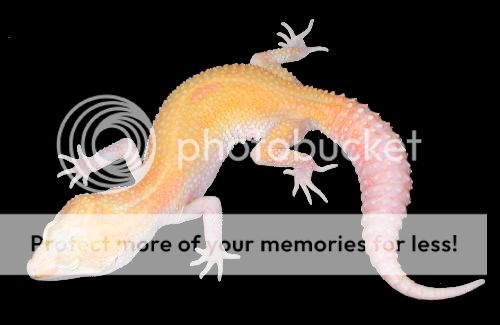← Mentorships


Common Name: Leopard Gecko
Latin name: Eublepharis macularius
Native to: Iran, Afghanistan, Pakistan, and India
Size: 8 to 9 inches
Life span: Up to 18 years.
General appearance: Leopard geckos are yellow background color with adults having brown spots. They have obvious ears and possess eyelids. They have no adhesive toe pads like other types of geckos, but do have claws on their toes.

Enclosure: A 20-gallon long aquarium will be adequate for 3 - 4 leopard geckos (only 1 male per enclosure — they are territorial). Rocks and logs will provide climbing areas and hiding places. Each leopard gecko must have its own hiding place. A lid is not necessary for the leopard geckos, since they do not climb glass, but will help keep crickets from escaping.
Temperature: Daytime high should be 82°F on one end of tank to 90°F under a spot light (choose wattage appropriate for providing the correct temperature. Night temperature should be 70° - 72° F. A small part of the substrate should be heated to 92°F using an under tank heat pad.
Heat/Light: No special UV lighting is needed as leopard geckos are nocturnal. A spotlight with the appropriate wattage bulb should be used for maintaining daytime heat/light. A under the tank heating pad works well to maintain daytime temperatures. And reb or Blue night bulb also works well for the night to help maintain temps. Just make sure you use a thermometer to watch your night and day temps.
Substrate: Anything from newspaper to sand may be used, but sand produces the most natural setup. Do NOT use cedar or Calcium sand.
Environment: Dry, arid type climate. However, the area under the hide box should be kept moist to aid shedding and simulate the leopard gecko's natural burrows. A shallow water dish should be available at all times.
Diet: Crickets, mealworms, wax worms for adult leopard geckos. Hatchlings and juveniles should be fed small, appropriately sized crickets only. Adult leopard geckos will also eat an occasional pinkie mouse. Crickets should be dusted with calcium/D3 powder and vitamin supplements at every feeding for hatchlings and juveniles, and every other feeding for adults. Avoid wild caught insects!
Maintenance: Keep substrate free of waste products. Water dish must be washed and refilled daily to prevent bacterial growth. Change substrate regularly.

This care sheet is designed to cover the basics of this animals needs for it to have a happy healthy life. There are many care sheets out there, and many animals may have different needs then what is listed here. Therefore we ask that you use this document as a guide, with the understanding that your animal may have differnt requirements then what is listed here.
RECENT KISMET
Hellhound (70)
Dear Diary.... I am a serial killer
07:15 - December 18 2025

Venerable Sire (132)
Werewolf Wednesday
03:40 - December 18 2025

Bloodsucker (50)
This World Shall Know Pain
01:59 - December 18 2025
REAL VAMPIRES LOVE VAMPIRE RAVE
Vampire Rave is a member of
Page generated in 0.0424 seconds.







